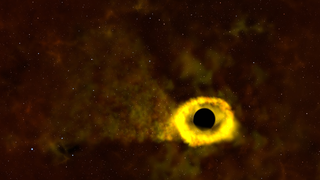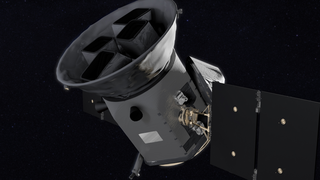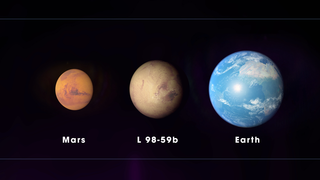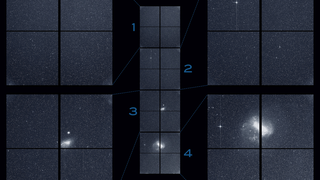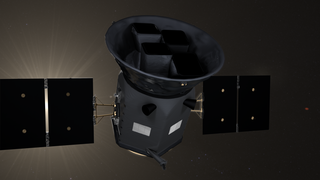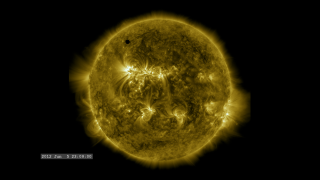Universe
ID: 13248

NASA’s Planet Hunter Reveals Exciting Discoveries in the Search for Strange New Worlds
Look Up! Planets Orbit All The Stars You Can See In The Night Sky
In its first year in orbit, NASA’s Transiting Exoplanet Survey Satellite, or TESS, scanned the skies in the southern hemisphere, where it discovered a variety of strange worlds. Next week, TESS will be unveiling some of its newest and most exciting discoveries about the planets orbiting the stars closest to us.
Join NASA scientists on Thursday, August 1 from 6:00 a.m. to 12:00 p.m. EDT to find out what TESS has discovered so far and how it is contributing to NASA’s search for life. Learn more about what scientists hope to find next, and how your viewers can join scientists and help NASA spot these distant worlds.
It wasn’t that long ago that scientists weren’t sure if there were planets orbiting other stars, just as Earth orbits the Sun. With help from telescopes both in space and on the ground, we now know that our galaxy is teeming with exoplanets, or planets that lie beyond our solar system. In fact, when you look up at the night sky, consider that just about every star you see might have at least one planet orbiting it...maybe many more.
NASA is diving deeper into the search for planets orbiting nearby stars with TESS and now as it enters year two, it will turn its gaze to the northern hemisphere, hunting for planets that orbit some of the stars we see each night with the naked eye.
*** To schedule an interview, fill out this form: https://forms.gle/Ln2PY6mCQ4sVmGxv9 ***
The Massachusetts Institute of Technology will be hosting the first science conference for TESS results the week of July 29th. Scientists will be available for in-person interviews Wednesday, July 31st from 2:00-4:00 and 4:30-6:30 p.m. ET. For more information click here: https://tsc.mit.edu/outreach.html. To RSVP email: Natalia Guerrero at nmg @mit.edu.
suggested questions
1) TESS has spent its first year scanning the skies for strange new worlds. What fascinating things did it discover?
2) How does TESS look for planets around other stars?
3) What are you excited for TESS to find as it turns to our local skies?
4) Traveling to even the closest stars would still take hundreds of thousands of years with our current technology. How are these distant planets relevant to us?
5) NASA is celebrating the 50th anniversary of the first Moon landing, with future plans to take astronauts to the Moon and then to Mars. What will studying the Moon and Mars up close tell us about planets around other stars?
6) How can our viewers learn more about this mission and get involved in looking for exoplanets?
satellite coordinates
HD Satellite Coordinates for G17-K18/Lower:
Galaxy 17 Ku-band Xp 18 Slot Lower| 91.0 ° W Longitude | DL 12051.0 MHz | Vertical Polarity | QPSK/DVB-S | FEC 3/4 | SR 13.235 Mbps | DR 18.2954 MHz | HD 720p | Format MPEG2 | Chroma Level 4:2:0 | Audio Embedded
*** Questions? Contact Courtney.a.lee@nasa.gov or 301-286-3131.***
Keep up to date on the latest with TESS on Twitter @NASA_TESS!
NASA’s Newest Planet Hunter To Reveal New Results From Its First Year In Orbit Live Shots

Look Up! Planets Orbit All The Stars You Can See In The Night Sky
In its first year in orbit, NASA’s Transiting Exoplanet Survey Satellite, or TESS, scanned the skies in the southern hemisphere, where it discovered a variety of strange worlds. Next week, TESS will be unveiling some of its newest and most exciting discoveries about the planets orbiting the stars closest to us.
Join NASA scientists on Thursday, August 1 from 6:00 a.m. to 12:00 p.m. EDT to find out what TESS has discovered so far and how it is contributing to NASA’s search for life. Learn more about what scientists hope to find next, and how your viewers can join scientists and help NASA spot these distant worlds.
It wasn’t that long ago that scientists weren’t sure if there were planets orbiting other stars, just as Earth orbits the Sun. With help from telescopes both in space and on the ground, we now know that our galaxy is teeming with exoplanets, or planets that lie beyond our solar system. In fact, when you look up at the night sky, consider that just about every star you see might have at least one planet orbiting it...maybe many more.
NASA is diving deeper into the search for planets orbiting nearby stars with TESS and now as it enters year two, it will turn its gaze to the northern hemisphere, hunting for planets that orbit some of the stars we see each night with the naked eye.
*** To schedule an interview, fill out this form: https://forms.gle/Ln2PY6mCQ4sVmGxv9 ***
The Massachusetts Institute of Technology will be hosting the first science conference for TESS results the week of July 29th. Scientists will be available for in-person interviews Wednesday, July 31st from 2:00-4:00 and 4:30-6:30 p.m. ET. For more information click here: https://tsc.mit.edu/outreach.html. To RSVP email: Natalia Guerrero at nmg @mit.edu.
suggested questions
1) TESS has spent its first year scanning the skies for strange new worlds. What fascinating things did it discover?
2) How does TESS look for planets around other stars?
3) What are you excited for TESS to find as it turns to our local skies?
4) Traveling to even the closest stars would still take hundreds of thousands of years with our current technology. How are these distant planets relevant to us?
5) NASA is celebrating the 50th anniversary of the first Moon landing, with future plans to take astronauts to the Moon and then to Mars. What will studying the Moon and Mars up close tell us about planets around other stars?
6) How can our viewers learn more about this mission and get involved in looking for exoplanets?
satellite coordinates
HD Satellite Coordinates for G17-K18/Lower:
Galaxy 17 Ku-band Xp 18 Slot Lower| 91.0 ° W Longitude | DL 12051.0 MHz | Vertical Polarity | QPSK/DVB-S | FEC 3/4 | SR 13.235 Mbps | DR 18.2954 MHz | HD 720p | Format MPEG2 | Chroma Level 4:2:0 | Audio Embedded
*** Questions? Contact Courtney.a.lee@nasa.gov or 301-286-3131.***
Keep up to date on the latest with TESS on Twitter @NASA_TESS!
Related
Credits
Lead Producer:
Courtney A. Lee (ADNET Systems, Inc.)
Producers:
Michelle Handleman (USRA)
Isabelle Yan (NASA/GSFC)
Chris Smith (USRA)
Scott Wiessinger (USRA)
Technical Support:
Aaron E. Lepsch (ADNET Systems, Inc.)
Courtney A. Lee (ADNET Systems, Inc.)
Producers:
Michelle Handleman (USRA)
Isabelle Yan (NASA/GSFC)
Chris Smith (USRA)
Scott Wiessinger (USRA)
Technical Support:
Aaron E. Lepsch (ADNET Systems, Inc.)
Please give credit for this item to:
NASA's Goddard Space Flight Center
NASA's Goddard Space Flight Center
Short URL to share this page:
https://svs.gsfc.nasa.gov/13248
Mission:
TESS
This item is part of these series:
Astrophysics B-Roll
Astrophysics Presentations
Keywords:
SVS >> HDTV
SVS >> Transit
SVS >> Astrophysics
NASA Science >> Universe
SVS >> Exoplanet
SVS >> TESS
https://svs.gsfc.nasa.gov/13248
Mission:
TESS
This item is part of these series:
Astrophysics B-Roll
Astrophysics Presentations
Keywords:
SVS >> HDTV
SVS >> Transit
SVS >> Astrophysics
NASA Science >> Universe
SVS >> Exoplanet
SVS >> TESS
